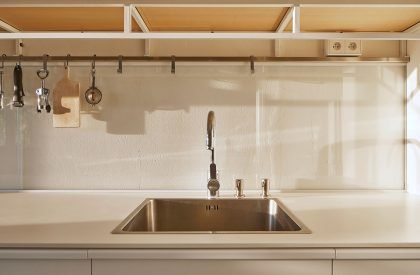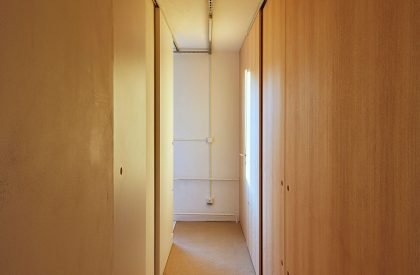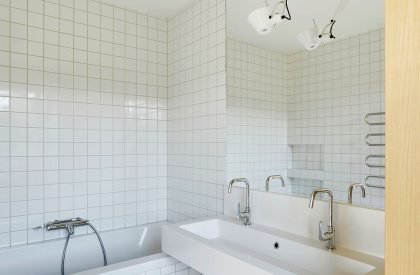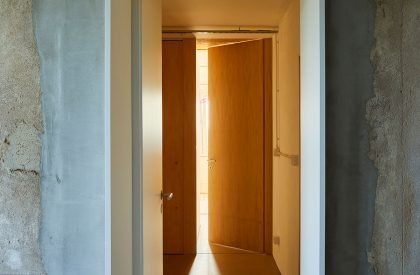Excerpt: Architect’s Apartment, a home interior project by RDTH architekti, used a method similar to restoring historical monuments, recognizing traces of interventions from different development periods. The design justified the 50-year-old panel building by contrasting the original structure with new elements and preserving existing construction interventions. To emphasise the numerous “imperfections,” the original panel and scratched plaster interiors are painted white.
Project Description

[Text as submitted by architect] The renovated apartment is designed to serve a family of three. The family requires a large living room to be the heart of the apartment. This space must accommodate a kitchen, a large table, an exercise area, and possibly even a children’s slide. As a result, it occupies an entire section of the apartment, defined by supporting panels. There is no room for an entrance hall or any unnecessary spatial features, as there are already more than enough in the common areas of the building. The family does not own a TV; instead, they watch movies and fairy tales using a projector.

The architect, who enjoys growing plants, ensures that the windows of the loggia, which offer a view of all of Prague, are shaded by climbing cucumbers in the summer. He carefully monitors their development every morning. Some tomatoes grow in pots, while others share a large self-watering container with ivy. He also enjoys comparing the fresh shoots of the five-leafed bougainvillaea, which extend from large flower pots at the other end of the loggia, training them along wires on the walls and ceiling to encourage their growth.



In addition to the living room, the family requires a room for their daughter. This room is nearly a mirror image of the guest room, which also doubles as an office. The two rooms are connected by sliding doors, allowing the family to run around the built-in cabinets. Initially, the living room was located on the side of the apartment without a loggia. The loggia was accessible only from one privileged residential room, but this has since changed. The entire layout has been restructured, and now the loggia can be accessed directly from the living room.
In addition to the rooms and built-in wardrobes, the second section of the apartment includes a toilet, a niche with a washing machine, and a comfortable bathroom with a bathtub. The bathroom no longer requires a fan, as a window now provides reliable ventilation within seconds. More importantly, the bathroom now benefits from natural light, which is a luxury in a panel building.


The HOA is strict. Among other things, it has prohibited any alterations to the load-bearing walls or ceiling panels for the purpose of installing distribution lines. The family did not want to lower the ceilings with plasterboard, which would have allowed them to conceal part of the wiring. They consider ceiling height to be one of the most valuable aspects of the space. As a result, they are likely the only ones in the building who respected this restriction and refrained from altering the vertical electrical distribution as well. Everything was installed along the surface, much like the original heating system. While bricklayers, plumbers, and electricians were less enthusiastic about this decision due to the need for precision in aligning rooms, openings, and tiles, the architect found satisfaction in these constraints, as they simplified decision-making and contributed to a natural aesthetic.



All new distribution networks are laid out in precise geometrical networks. The architect also told the workers they couldn’t cut the small 10×10 tiles because it had been calculated exactly, so there would be no need to cut them. They were also sometimes surprised that the architect didn’t want them to level and plaster the spots and unevenness in the plaster after tearing down the polystyrene insulation of the ceilings. The same approach was taken when adjusting the unevenness that remained on the ceilings after the demolition of all the load-bearing partitions. The masons were instructed to clean them roughly and then impregnate and whitewash the entire surface. The architect didn’t mind the inequalities at all; in fact, they liked them, seeing it as an honest decoration that came at no extra cost.


Naturally, the masons were surprised when the architect was critical of millimetres of unevenness in the new walls or in the joints of the new floor, which were expected to be uniform along the walls. The architect hinted that they were concerned with the contrast between the original building and the newly inserted elements but chose not to explain it further, as it likely wouldn’t align with the workers’ perspective.
There was also no explanation provided about not minding traces of the original construction interventions or removed walls. Nor was it explained that this approach is somewhat akin to restoring historical monuments, where, according to one philosophical school of thought, it’s desirable to recognize traces of interventions from different periods of development. The architect understood that using this method in a panel building might be unusual, but still believed it was legitimate given that the house was almost 50 years old.
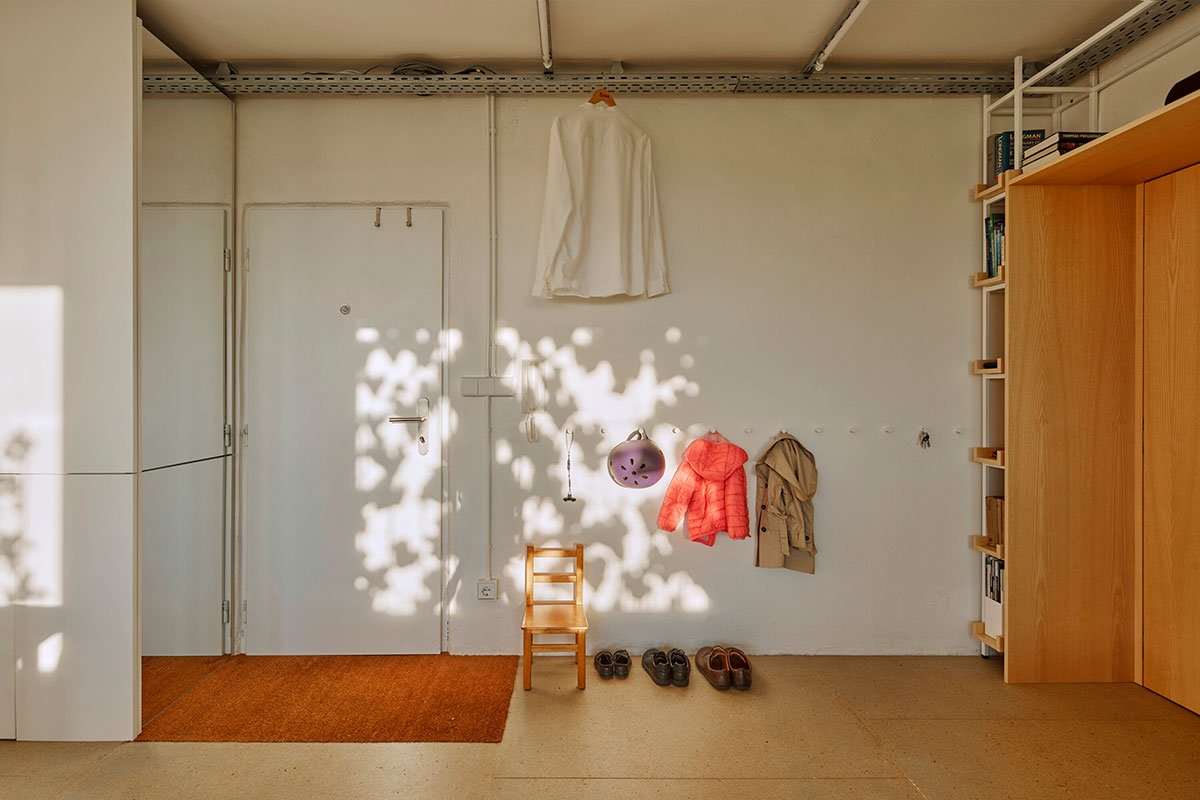
Repairing an apartment in a panel building does not have to be cheap. There is a lot of carpentry in the apartment, and ash veneer was used inside the cabinets intentionally. The bedroom is narrow, just the width of the bed, but one day it will be completely panelled like a cabin, also with ash. For now, however, the architect is pleased with the scratched plaster and the original panel with its countless “imperfections,” which they painted white. The panel was supposed to remain grey, but it was painted white because they weren’t paying attention and were a few minutes late. Their daughter, almost three years old at the time, had already started painting. There was a misunderstanding. So, the architect ended up painting one concrete wall white to match the others.











